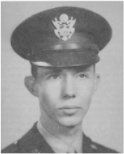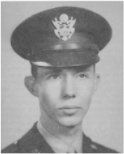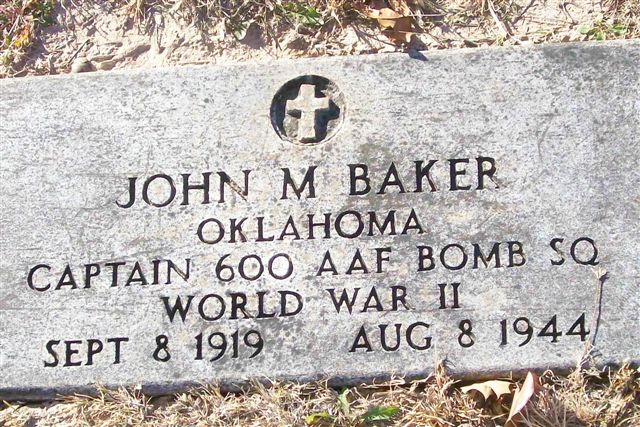Jim was born in Oklahoma City on 8 September 1919, son of Lemuel and Sarah Baker. He graduated from high school in Oklahoma City and from junior college (the Oklahoma Military Academy—OMA) prior to entering West Point in 1938.
My days with Jim go back to my introduction to West Point on 1 July 1938 when we both arrived there as plebes. This calm, taciturn Southwesterner with his seemingly extensive military background (two years of Reserve Officers Training Corps at Oklahoma Military Academy), was a godsend to me, a green, frightened high school kid from the upper Midwest. Jim taught me a lot, quickly, about the military way of doing things and how to relax and adapt to the terrible strains of plebe year. I think he also helped the third member of our room crew, Buster Brandon, who, although he was older than either of us, probably needed calming and caring as much as I did.
Despite three more years of close association (not always as roommates) in K Company, the first few months made a deep impression. I remember Jim: very calm under pressure, compassionate and helpful, competent and businesslike. Another classmate, a roommate of Jim’s in a later year, remembers him as intelligent, quick-witted, good-hearted, resilient, “whose company I enjoyed and whose integrity I respected.”
Jim was a fairly active cadet; he played soccer as a plebe, and he was manager of Varsity Swimming as a First Classman, after being an assistant during his Second and Third Class years. He belonged to the Chess Club and was in several 100th Nite shows. His graduation standing of 109 in a class of 374 enabled him to choose the Field Artillery and a detail in the Air Corps. Jim and I went our separate ways after graduation (I to the Army Engineers and he to the Air Corps Bombardiers) and what with wartime ‘busyness’ and preoccupation, we never further communicated. All that I know of him from then until his untimely death in August 1944, I have since learned from others or from semi-official records.
With 19 of his classmates, in the then great urgency of the early days of World War II—Jim had 5 days travel time after graduation on 29 May 1942 to report to Corsicana, Texas for primary flying training. Even then, one of his classmates reports, they were several days late for the start of the course which the rest of the air cadets and student officers must have started about 1 June 1942. At the end of the 10 week course Jim, along with some others, was transferred to Randolph Field, Texas for a one-month period of basic training, and this was followed by a two-month period of further training at Foster Field, Texas which was completed on 13 December 1942.
I have tried to reconstruct Jim’s pitifully short career in the Army Air Corps from information provided by two classmates and his widow, and from the cold, biographical details in the Cullum Register of 1950. Jim and Lucy Evaline Cunningham were married on 14 December 1942 which was the day after Jim completed training at Foster Field. (Jim and Lucy had been high school sweethearts and corresponded during his years at West Point, and in fact, Lucy had attended Jim’s graduation.) We can visualize—and some of us remember vividly from personal experience—how difficult it was to schedule and otherwise plan a wedding ceremony in the hectic wartime years.
In any event, Jim then embarked on training and operational duties in the Air Corps, during the 16 months from December 1942 to April 1944, which included assignments to Brooks Field, Texas (50 days), Godman Field, Fort Knox, Kentucky (100 days), Florence Field, South Carolina (15 days), Lockbourne Army Air Base, Ohio (25 days), Pyote Army Air Base, Texas (15 days), Dyersburg Field, Tennessee (80 days), and Rapid City Army Air Base, South Dakota (90 days). Jim, with many others, was caught up in a great demand for B-17 and B-24 bomber pilots and crews in 1943 which resulted in quick transition courses for many officers like Jim and assignment to groups headed overseas. In Jim’s case, it was the 389th Bomb Group at Rapid City, the last B-17 group to be sent to Europe.
As Jim was completing his final preparations for taking his bomber and crew overseas, his son, John Marion Baker Jr., was born on 26 March 1944 in Oklahoma City. Jim named his new B-17, which he and the crew would soon fly to England, “Little John,” in honor of his son and in one of those small, good fortunes of war, he and his crew were able to fly down to Oklahoma City to see Lucy and little John Baker, then only a few days old, before they departed for overseas. However, after flying their plane “Little John” to England in April 1944, Jim and the crew discovered that the plane would be taken from them by a ferry crew to a modification center, and they did not see it again.
Jim and his crew flew a number of missions over the Continent from England (Jim was awarded 7 Air Medals), but on 8 August 1944, his plane, on a mission over Cherbourg, received a direct hit from anti-aircraft fire and went into a spin and crashed. Although two crew members survived as prisoners of war, Jim and the rest of the crew died in the crash. Jim’s Air Medal citation reads as follows: “For exceptionally meritorious achievement, while participating in sustained bomber/combat operations over enemy occupied Continental Europe. The courage, coolness and skill displayed by this officer upon these occasions reflect great credit upon himself and the Armed Forces of the United States.”
Jim, many of us wish we had been able to know you better and longer. You have shown us why we are in the military service. We are prepared to give our lives to our country and some, like Jim Baker, and a large number of his classmates, were called for the full sacrifice. God bless him and them.
(Jim’s widow, Lucy, was married to Dr. Jack Glasgow in 1959. Jim’s and Lucy’s son, John Marion Baker Jr. is a civil engineer, and his father would be proud of him.)
—Phil Krueger with Lucy Baker Glasgow and Sam Gustaves
Jim was born in Oklahoma City on 8 September 1919, son of Lemuel and Sarah Baker. He graduated from high school in Oklahoma City and from junior college (the Oklahoma Military Academy—OMA) prior to entering West Point in 1938.
My days with Jim go back to my introduction to West Point on 1 July 1938 when we both arrived there as plebes. This calm, taciturn Southwesterner with his seemingly extensive military background (two years of Reserve Officers Training Corps at Oklahoma Military Academy), was a godsend to me, a green, frightened high school kid from the upper Midwest. Jim taught me a lot, quickly, about the military way of doing things and how to relax and adapt to the terrible strains of plebe year. I think he also helped the third member of our room crew, Buster Brandon, who, although he was older than either of us, probably needed calming and caring as much as I did.
Despite three more years of close association (not always as roommates) in K Company, the first few months made a deep impression. I remember Jim: very calm under pressure, compassionate and helpful, competent and businesslike. Another classmate, a roommate of Jim’s in a later year, remembers him as intelligent, quick-witted, good-hearted, resilient, “whose company I enjoyed and whose integrity I respected.”
Jim was a fairly active cadet; he played soccer as a plebe, and he was manager of Varsity Swimming as a First Classman, after being an assistant during his Second and Third Class years. He belonged to the Chess Club and was in several 100th Nite shows. His graduation standing of 109 in a class of 374 enabled him to choose the Field Artillery and a detail in the Air Corps. Jim and I went our separate ways after graduation (I to the Army Engineers and he to the Air Corps Bombardiers) and what with wartime ‘busyness’ and preoccupation, we never further communicated. All that I know of him from then until his untimely death in August 1944, I have since learned from others or from semi-official records.
With 19 of his classmates, in the then great urgency of the early days of World War II—Jim had 5 days travel time after graduation on 29 May 1942 to report to Corsicana, Texas for primary flying training. Even then, one of his classmates reports, they were several days late for the start of the course which the rest of the air cadets and student officers must have started about 1 June 1942. At the end of the 10 week course Jim, along with some others, was transferred to Randolph Field, Texas for a one-month period of basic training, and this was followed by a two-month period of further training at Foster Field, Texas which was completed on 13 December 1942.
I have tried to reconstruct Jim’s pitifully short career in the Army Air Corps from information provided by two classmates and his widow, and from the cold, biographical details in the Cullum Register of 1950. Jim and Lucy Evaline Cunningham were married on 14 December 1942 which was the day after Jim completed training at Foster Field. (Jim and Lucy had been high school sweethearts and corresponded during his years at West Point, and in fact, Lucy had attended Jim’s graduation.) We can visualize—and some of us remember vividly from personal experience—how difficult it was to schedule and otherwise plan a wedding ceremony in the hectic wartime years.
In any event, Jim then embarked on training and operational duties in the Air Corps, during the 16 months from December 1942 to April 1944, which included assignments to Brooks Field, Texas (50 days), Godman Field, Fort Knox, Kentucky (100 days), Florence Field, South Carolina (15 days), Lockbourne Army Air Base, Ohio (25 days), Pyote Army Air Base, Texas (15 days), Dyersburg Field, Tennessee (80 days), and Rapid City Army Air Base, South Dakota (90 days). Jim, with many others, was caught up in a great demand for B-17 and B-24 bomber pilots and crews in 1943 which resulted in quick transition courses for many officers like Jim and assignment to groups headed overseas. In Jim’s case, it was the 389th Bomb Group at Rapid City, the last B-17 group to be sent to Europe.
As Jim was completing his final preparations for taking his bomber and crew overseas, his son, John Marion Baker Jr., was born on 26 March 1944 in Oklahoma City. Jim named his new B-17, which he and the crew would soon fly to England, “Little John,” in honor of his son and in one of those small, good fortunes of war, he and his crew were able to fly down to Oklahoma City to see Lucy and little John Baker, then only a few days old, before they departed for overseas. However, after flying their plane “Little John” to England in April 1944, Jim and the crew discovered that the plane would be taken from them by a ferry crew to a modification center, and they did not see it again.
Jim and his crew flew a number of missions over the Continent from England (Jim was awarded 7 Air Medals), but on 8 August 1944, his plane, on a mission over Cherbourg, received a direct hit from anti-aircraft fire and went into a spin and crashed. Although two crew members survived as prisoners of war, Jim and the rest of the crew died in the crash. Jim’s Air Medal citation reads as follows: “For exceptionally meritorious achievement, while participating in sustained bomber/combat operations over enemy occupied Continental Europe. The courage, coolness and skill displayed by this officer upon these occasions reflect great credit upon himself and the Armed Forces of the United States.”
Jim, many of us wish we had been able to know you better and longer. You have shown us why we are in the military service. We are prepared to give our lives to our country and some, like Jim Baker, and a large number of his classmates, were called for the full sacrifice. God bless him and them.
(Jim’s widow, Lucy, was married to Dr. Jack Glasgow in 1959. Jim’s and Lucy’s son, John Marion Baker Jr. is a civil engineer, and his father would be proud of him.)
—Phil Krueger with Lucy Baker Glasgow and Sam Gustaves
Family Members
Other Records
Sponsored by Ancestry
Advertisement
Records on Ancestry
Advertisement









